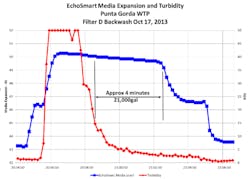Instruments Improve Backwash System & Data
Analytical Technology Inc. - Entech Design Products, www.entechdesign.com, 940.898.1173
The Punta Gorda WTP is a 10 million gallon per day surface drinking water facility located just east of Punta Gorda, Florida. The process includes floc tanks, four solids contact units (SCUs), which are a form of upflow clarifier. They then feed two Greenleaf Filters with four cells each. The filters are backwashed every 70 hours regardless of head loss. High backwash flow rate is 5200 gpm. The total cost to treat 1,000 gallons of drinking water is $1.73.
The plant became aware of the FilterSmart media level and turbidity monitors in 2013 when Tom Jackson, the utilities director for Punta Gorda, attended a presentation on FilterSmart at the AL/FL Joint Rural Water Conference and passed the information along to Brian Fuller, the plant supervisor. Brian arranged for a field trial and subsequently purchased instruments to outfit the filters.
Filter Run Times Extended From 70 to 120 Hours
During the field trial, it was noted that the loading in the filters was very light. This can be seen in the relatively low turbidity measured during the backwash. Since the backwash schedule was based on time and not head loss, the suggestion was made to incrementally increase the filter run times (FRTs) until the head loss value was reached. FRTs were increased to roughly 150 hours at one point, but were backed off to 120 hours due to various concerns. This initial process adjustment resulted in a 42% decrease in backwash water consumption annually at a value of approximately $65,000.
High Rate Backwash Flow Duration Reduced Four Minutes
Once the instruments were purchased and installed, backwash data also indicated that the high rate portion of the backwash was longer than necessary, and was reduced by four minutes. This adjustment resulted in a savings of approximately 22,100 gallons of wash water per wash, at a value of $21,000 annually.
Together, these two simple adjustments to the backwash process resulted in $86,000 in savings the first year. These savings are more than twice the total price of the instruments.
Dramatic Savings Through Sludge Measurement in Drying & Handling Process
The flow of water in the SCUs is up through a blanket of sludge and into collection pipes, which send the water to the filters. The sludge blanket rises to a level where it cascades into a trough, from which it is pumped to the drying process. An EchoSmart sludge blanket monitor was installed in each of the four sludge troughs with the signals used to control the sludge pumps. The goal was to keep the sludge level in the troughs within a 6- to 8-inch range. Previously, the sludge pumps were turned on and off manually, which produced inconsistent results. Using the EchoSmart blanket level to control the pumps eliminated these inconsistencies, and greatly reduced the hydraulic loading to the sludge drying train.
In addition to these documented savings, there are others that have not been documented. For example, the driver of the front end loader is free to resume other maintenance activities. Additionally, fuel for the front end loader, the polymer used prior to the sludge press and the tipping fees to haul the sludge to the dump all reduced as well.
Summary
All told, the savings to the plant in the first couple of years after installing the FilterSmart and EchoSmart monitors could easily reach more than a half million dollars.
“We love these instruments,” Jackson said. “They’ve given us data that we can use to make decisions that have saved us a lot of money.”
